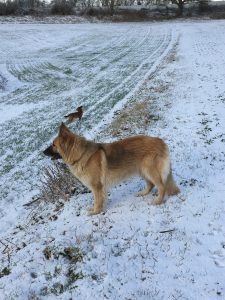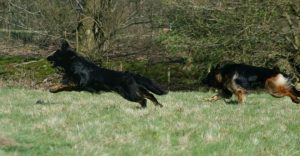The German Shepherd Dog
In the Holidays4Dogs series of breed articles, we look this time at another popular breed – the German Shepherd Dog. If you are thinking of getting a German Shepherd dog, read on for more information on this super breed of dog.
German shepherds are fairly large imposing dogs. They can make wonderful family pets in the right environment. However, like many other herding and working breeds, they do need an active lifestyle and careful socialisation as puppies.
History.
The history of the G.S.D can be traced back to 1889 with a foundation dog called, Horand Von Grafrath. Horand was a wolf-like dog competing at dog shows in West Germany. The dog was purchased by Captain Max von Stephanhitz who set about standardising the breed.
who set about standardising the breed.
Although Stephanitz believed aesthetics were less important than intelligence and utility, his early breeding programme involved intense inbreeding and later out-crossing to unrelated herding dogs.
As industrialisation encroached upon pastoral areas in Germany, Stephanitz became concerned that shepherd dogs may also decline.
In collaboration with the police and various working dog clubs, a set of tests were developed for tracking, obedience and protection. These tests were the foundation of Shutzhund trials; a sport which many owners of G.S.D’s partake in today.
Types.
There are many different types of German shepherd dogs today. It is important to consider these various strains before purchasing a German Shepherd puppy. 
Show-bred German, or English dogs, for example, differ both aesthetically and, often in terms of temperament, from East German, or Czechoslovakian Dogs.
Show-bred dogs often have a more angulated top line, (sloping back), and this has long been a bone of contention among enthusiasts of the breed. East German dogs are generally sturdier with a straighter back line.
To delve too far into the nuances of different strains (types) of the G.S.D would be beyond the realms of this article. However, the wise would-be owner will spend some considerable time researching the breed. It would be sensible to consider what expectations you have from owning a shepherd.
Many responsible breeders of German shepherd dogs are often reluctant to sell puppies solely as companion animals. Many will favour buyers already involved in obedience, or working trails, ( or with intentions to). German shepherds need a great deal of physical and mental stimulation and without it, their behaviour can be challenging.
Unfortunately, there are around fifty hereditary diseases which affect this breed. The four main ones are;-
- Hip dysplasia,
- Degenerative myelopathy,
- Haemophilia A
- Pancreatic acinar Atrophy.
In addition, it is essential that you choose a puppy from parents with stable temperaments. Nervousness in German shepherds is a fault that Stephanitz himself recognised and warned against. Always spend time visiting lots of different breeders and meeting their adult dogs.
Character.
These dogs can grow to be very big and the long-coated dogs, in particular, can bring a lot of mud and hair into the house in copious quantities. They are natural guards and protectors and, therefore, they can be quite vocal. As a large breed, they can also be quite clumsy and with their exuberant natures, can easily knock over small children. They thrive on activities; a bored G.S.D can be quite destructive and apt to develop undesirable behaviour if kept isolated.
Without question, new owners should enrol in dog training classes as soon as possible. Ideally, training should be taken forward by engaging regularly in some form of dog sport, such as obedience, agility or working trials.


